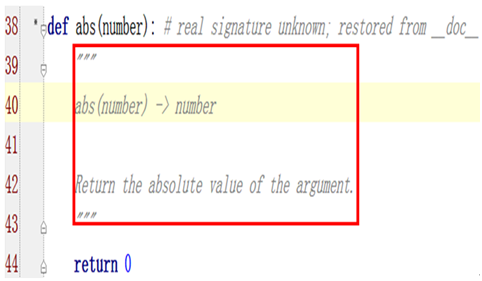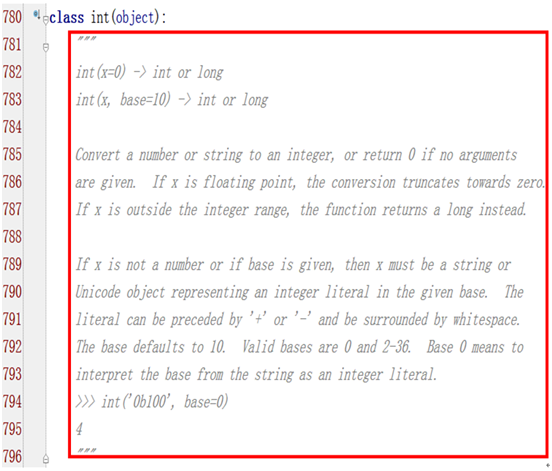Python獲取幫助的3種方式
我們可以很容易的通過Python直譯器獲取幫助。如果想知道一個物件(object)更多的資訊,那麼可以呼叫help(object)!另外還有一些有用的方法,dir(object)會顯示該物件的大部分相關屬性名,還有object._ doc _會顯示其相對應的文件字串。下面對其進行逐一介紹。
1、 help()
help函式是Python的一個內建函式。
函式原型:help([object])。
可以幫助我們瞭解該物件的更多資訊。
If no argument is given, the interactive help system starts on the interpreter console.
>>> help()
Welcome to Python 2.7! This is the online help utility.
If this is your first time using Python, you should definitely check out
the tutorial on the Internet at http://docs.python.org/2.7/tutorial/.
Enter the name of any module, keyword, or topic to get help on writing
Python programs and If the argument is a string, then the string is looked up as the name of a module, function, class, method, keyword, or documentation topic, and a help page is printed on the console. If the argument is any other kind of object, a help page on the object is generated.
>>> help(abs) # 檢視abs函式
Help on built-in function abs in module __builtin__:
abs(...)
abs(number) -> number
Return the absolute value of the argument.
>>> help(math) # 檢視math模組,此處只顯示部分內容
Help on built-in module math:
NAME
math
FILE
(built-in)
DESCRIPTION
This module is always available. It provides access to the
mathematical functions defined by the C standard.
FUNCTIONS
acos(...)
acos(x)
Return the arc cosine (measured in radians) of x.
.....
>>>
2、dir()
dir函式是Python的一個內建函式。
函式原型:dir([object])
可以幫助我們獲取該物件的大部分相關屬性。
Without arguments, return the list of names in the current local scope.
>>> dir() # 沒有引數
['__builtins__', '__doc__', '__name__', '__package__']
>>>
>>> import math # 引入一個包和一個變數,再次dir()
>>> a=3
>>>
>>> dir()
['__builtins__', '__doc__', '__name__', '__package__', 'a', 'math']
>>>
With an argument, attempt to return a list of valid attributes for that object.
>>> import math
>>> dir(math) # math模組作為引數
['__doc__', '__name__', '__package__', 'acos', 'acosh', 'asin', 'asinh', 'atan', 'atan2', 'atanh', 'ceil', 'copysign', 'cos', 'cosh', 'degrees', 'e', 'erf', 'erfc', 'exp', 'expm1', 'fabs', 'factorial', 'floor', 'fmod', 'frexp', 'fsum', 'gamma', 'hypot', 'isinf', 'isnan', 'ldexp', 'lgamma', 'log', 'log10', 'log1p', 'modf', 'pi', 'pow', 'radians', 'sin', 'sinh', 'sqrt', 'tan', 'tanh', 'trunc']
>>>
The default dir() mechanism behaves differently with different types of objects, as it attempts to produce the most relevant, rather than complete, information:
• If the object is a module object, the list contains the names of the module’s attributes.
>>> import math
>>> dir(math) # math模組作為引數
['__doc__', '__name__', '__package__', 'acos', 'acosh', 'asin', 'asinh', 'atan', 'atan2', 'atanh', 'ceil', 'copysign', 'cos', 'cosh', 'degrees', 'e', 'erf', 'erfc', 'exp', 'expm1', 'fabs', 'factorial', 'floor', 'fmod', 'frexp', 'fsum', 'gamma', 'hypot', 'isinf', 'isnan', 'ldexp', 'lgamma', 'log', 'log10', 'log1p', 'modf', 'pi', 'pow', 'radians', 'sin', 'sinh', 'sqrt', 'tan', 'tanh', 'trunc']
>>>
• If the object is a type or class object, the list contains the names of its attributes, and recursively of the attributes of its bases.
>>> dir(float) # 型別
['__abs__', '__add__', '__class__', '__coerce__', '__delattr__', '__div__', '__divmod__', '__doc__', '__eq__', '__float__', '__floordiv__', '__format__', '__ge__', '__getattribute__', '__getformat__', '__getnewargs__', '__gt__', '__hash__', '__init__', '__int__', '__le__', '__long__', '__lt__', '__mod__', '__mul__', '__ne__', '__neg__', '__new__', '__nonzero__', '__pos__', '__pow__', '__radd__', '__rdiv__', '__rdivmod__', '__reduce__', '__reduce_ex__', '__repr__', '__rfloordiv__', '__rmod__', '__rmul__', '__rpow__', '__rsub__', '__rtruediv__', '__setattr__', '__setformat__', '__sizeof__', '__str__', '__sub__', '__subclasshook__', '__truediv__', '__trunc__', 'as_integer_ratio', 'conjugate', 'fromhex', 'hex', 'imag', 'is_integer', 'real']
>>> dir(3.4)
['__abs__', '__add__', '__class__', '__coerce__', '__delattr__', '__div__', '__divmod__', '__doc__', '__eq__', '__float__', '__floordiv__', '__format__', '__ge__', '__getattribute__', '__getformat__', '__getnewargs__', '__gt__', '__hash__', '__init__', '__int__', '__le__', '__long__', '__lt__', '__mod__', '__mul__', '__ne__', '__neg__', '__new__', '__nonzero__', '__pos__', '__pow__', '__radd__', '__rdiv__', '__rdivmod__', '__reduce__', '__reduce_ex__', '__repr__', '__rfloordiv__', '__rmod__', '__rmul__', '__rpow__', '__rsub__', '__rtruediv__', '__setattr__', '__setformat__', '__sizeof__', '__str__', '__sub__', '__subclasshook__', '__truediv__', '__trunc__', 'as_integer_ratio', 'conjugate', 'fromhex', 'hex', 'imag', 'is_integer', 'real']
>>>
>>> class A:
x=3
y=4
>>> class B(A):
z=5
>>> dir(B) # 類
['__doc__', '__module__', 'x', 'y', 'z']
>>>
• Otherwise, the list contains the object’s attributes’ names, the names of its class’s attributes, and recursively of the attributes of its class’s base classes.
3、_ doc_
在Python中有一個奇妙的特性,文件字串,又稱為DocStrings。
用它可以為我們的模組、類、函式等新增說明性的文字,使程式易讀易懂,更重要的是可以通過Python自帶的標準方法將這些描述性文字資訊輸出。
上面提到的自帶的標準方法就是_ doc _。前後各兩個下劃線。
注:當不是函式、方法、模組等呼叫doc時,而是具體物件呼叫時,會顯示此物件從屬的型別的建構函式的文件字串。
>>> import math
>>> math.__doc__ # 模組
'This module is always available. It provides access to the\nmathematical functions defined by the C standard.'
>>> abs.__doc__ # 內建函式
'abs(number) -> number\n\nReturn the absolute value of the argument.'
>>> def addxy(x,y):
'''the sum of x and y'''
return x+y
>>> addxy.__doc__ # 自定義函式
'the sum of x and y'
>>> a=[1,2,4]
>>> a.count.__doc__ # 方法
'L.count(value) -> integer -- return number of occurrences of value'
>>> b=3
>>> b.__doc__ # 具體的物件
"int(x=0) -> int or long\nint(x, base=10) -> int or long\n\nConvert a number or string to an integer, or return 0 if no arguments\nare given. If x is floating point, the conversion truncates towards zero.\nIf x is outside the integer range, the function returns a long instead.\n\nIf x is not a number or if base is given, then x must be a string or\nUnicode object representing an integer literal in the given base. The\nliteral can be preceded by '+' or '-' and be surrounded by whitespace.\nThe base defaults to 10. Valid bases are 0 and 2-36. Base 0 means to\ninterpret the base from the string as an integer literal.\n>>> int('0b100', base=0)\n4"
>>>
其實我們可以通過一定的手段來檢視這些文件字串,比如使用Pycharm,在對應的模組、函式、方法等上滑鼠“右擊”->Go to->Declaration。例如:檢視內建函式abs的文件字串

我們再舉一個具體的物件的例子,例如,上面具體的整型物件b的doc顯示的就是其所從屬的int型別的文件字串:
參考文獻:
1、Python幫助文件

